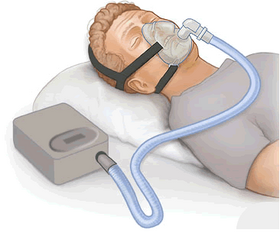| Positive airway pressure | |
|---|---|
 CPAP therapy: flow generator, hose, orinasal mask | |
| Specialty | Pulmonary |
Positive airway pressure (PAP) is a mode of respiratory ventilation used in the treatment of sleep apnea. PAP ventilation is also commonly used for those who are critically ill in hospital with respiratory failure, in newborn infants (neonates), and for the prevention and treatment of atelectasis in patients with difficulty taking deep breaths. In these patients, PAP ventilation can prevent the need for tracheal intubation, or allow earlier extubation. Sometimes patients with neuromuscular diseases use this variety of ventilation as well. CPAP is an acronym for "continuous positive airway pressure", which was developed by Dr. George Gregory and colleagues in the neonatal intensive care unit at the University of California, San Francisco.[1] A variation of the PAP system was developed by Professor Colin Sullivan at Royal Prince Alfred Hospital in Sydney, Australia, in 1981.[2]
The main difference between BPAP and CPAP machines is that BPAP machines have two pressure settings: the prescribed pressure for inhalation (ipap), and a lower pressure for exhalation (epap). The dual settings allow the patient to get more air in and out of their lungs.
- ^ Gregory GA; Kitterman JA; Phibbs RH; Tooley WH; Hamilton WK (1971). "Treatment of the idiopathic respiratory-distress syndrome with continuous positive airway pressure". The New England Journal of Medicine. 284 (24): 1333–40. doi:10.1056/NEJM197106172842401. PMID 4930602.
- ^ "Sleepfoundation.com". Retrieved September 1, 2010.